#bookconservation
Text
Preserving Leaf Paintings in an Anglo-Indian Commonplace Book, 1822-1825
Hello, I’m Alexa Machnik, a third-year graduate student at the Conservation Center, Institute of Fine Arts, NYU. I first came to the Barbara Goldsmith Preservation & Conservation Department in Fall 2022 as a student in the graduate course, Conservation in Context, taught by Laura McCann, Director of Preservation. During this course, we delved into the world of library conservation, exploring the value systems that guide preservation decision-making and treatment action in academic research libraries. One of my class projects involved rehousing delicate leaf paintings from an early 19th-century commonplace book, or friendship album, part of the Fales Library holdings in the Special Collections at NYU Libraries (figs. 1-2) [1]. In honor of Preservation Week, I will share the intriguing history of the book and discuss the decisions that were made to preserve the leaves.

Figure 1 [left]: Front cover of the commonplace book, bound in gold-tooled red morocco leather.
Figure 2 [right]: Ownership label of “Jane Harriet [Blechynden]” on front marbled pastedown.
The book in question was compiled by Jane Harriet Blechynden (1806-1827) in England between 1822 and 1825. It holds her personal collection of handwritten and acquired materials, with contributions from her sisters, Emma and Sarah, who wrote original poems about sisterhood, separation, and their Anglo-Indian ancestry. The three women were the daughters of a British merchant residing in Calcutta, and while born in India, they were educated in England [2]. There is not a great deal known about Jane Harriet’s life in England, but her impending return to India in 1825 is documented in an emotional verse by Emma (fig. 3):
“Thus in parting my sister we’re breaking a link / Which may ne’er be united again / And firm as that chain was ‘tis painful to think / That absence may send it twain.”

Figure 3: Excerpt from the original poem, “Parting and a Meeting,” signed by Emma.
Jane Harriet’s book offers insights into her personhood, social connections, and sensibilities as an artist and collector. In addition to written entries, she inserted a compendium of acquired materials–pressed flowers, her own original drawings, and numerous paintings–between pages of the book (figs. 4-6).

Figures 4-6 [left to right]: A small sampling of the ephemeral treasures found in the book, including a dried pressed flower, a drawing on pith possibly by Jane Harriet, and a cut-paper silhouette.
Notably, six of these paintings are executed on the dried leaves of the Bodhi tree, a sacred plant indigenous to Asia with distinct spade-shaped, long-tipped leaves (fig. 7) [3]. Although leaf painting has origins in Buddhist traditions, by the time Jane Harriet collected her leaf paintings, it had already evolved into a form of Chinese export art in Europe. Her leaves depict secular scenes of contemporary life in China and botanical subjects, which are typical of the export genre (fig. 8). Their inclusion in the book implies that Jane was among the many people who partook in the avid collecting of China trade goods during the first few decades of the 19th century, a time when European fascination for Chinese culture and art was at its peak.

Figure 7: A leaf painting, as found loose in the book and partially lifted to show the thin, translucent nature of the leaf support.

Figure 8: Another leaf painting from the book, oriented with the leaf tip at the bottom of the image, depicting flowers and a butterfly.
The initial rush of excitement that I felt at finding the leaf paintings soon turned to concern as I gave thought to their long-term preservation at NYU Libraries, where researchers are expected to handle the book. The leaf paintings were loose in between the pages, which raised a series of “what ifs” about the potential dangers they could encounter. What if the leaves slip from the book? What if they bend or break as the pages are turned? What if the painted surfaces become abraded? The paintings were made with opaque pigment-based watercolors on exceptionally delicate, skeletonized leaves that have been primed with a thin organic coating. Despite being intact, their inherent fragility means that they are vulnerable to even the slightest touch. After considerable discussion, the Conservation Unit decided that in order for the leaf paintings to be preserved and safely accessed by researchers, they should be housed separately from the book.
I thoroughly examined the condition of the leaves and the painted surfaces in order to make a housing recommendation. Despite some minor damage, all were in stable condition. Thus, the ideal housing would provide support to prevent any further damage, such as paint loss and leaf breakage, and at the same time allow the leaves to maintain their translucency. To achieve this, I opted to mount them in double-sided window mats with a support made from clear polyester film, or Mylar® [4]. The addition of the Mylar® would not only create a stable surface for the leaf paintings but also enable the viewing of both sides (fig. 9).
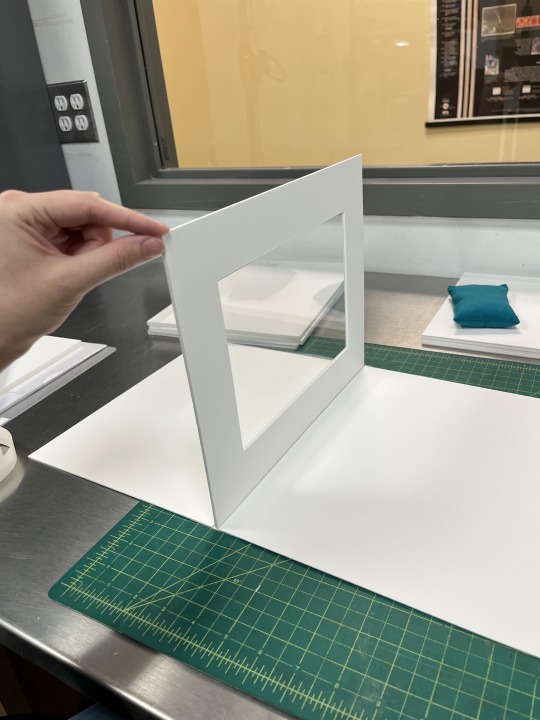
Figure 9: View of the double-sided window mat with a Mylar® support.
My next challenge was to figure out how to mount the leaves onto the Mylar® support without the use of adhesive [5]. After consulting with conservation staff and creating mock-ups, short, discreet Mylar® tabs were selected as the best option to secure them into place (figs. 10-11). For this process, I positioned a single leaf painting onto the support and selectively placed the tabs around its perimeter, making sure the tabs did not overlap any areas of paint. I then used a handheld spot-welding pen to fuse the tabs to the support. Since this process was done in-situ, near the leaf, it required lots of precision practice and encouragement from colleagues before I felt confident enough for the task.

Figure 10: Detail of a mounted leaf painting. Notice that the Mylar® tabs are welded just outside the leaf and extend minimally over the edges, holding it in place with gentle pressure.

Figure 11: The backside of a mounted leaf painting viewed through the Mylar® support. This gives researchers access to the painting’s verso, where an underdrawing and other signs of artistic process can be discerned.
At the time of writing this post, I successfully housed the six leaf paintings in their double-sided window mats (figs. 12-13). This housing project, while complete, is just one part of the ongoing effort to preserve the commonplace book, and the Conservation Unit is continuing work on other elements of the book to ensure its safe return to Special Collections.
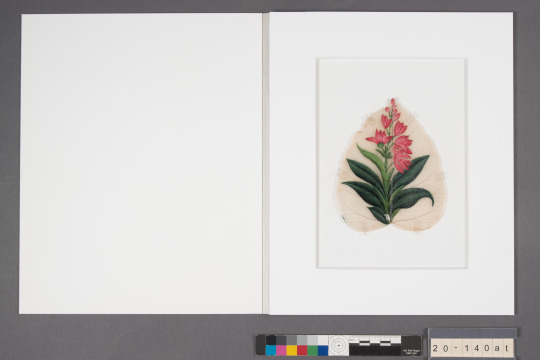
Figure 12: Example of the completed housing, showing the front of a leaf painting.

Figure 13: Back of a leaf painting.
Though my involvement in the project has come to an end, I have gained a very special appreciation for the commonplace book and the preservation challenges it presents. The experience of learning directly from NYU Libraries Special Collections was especially invaluable, providing me with opportunities to participate in complex decision-making processes unique to large research libraries driven by user needs. Before signing off, I’d like to extend my gratitude to my supervisors, Laura McCann, Director, and Lindsey Tyne, Conservation Librarian, and the entire team at the Barbara Goldsmith Conservation Lab for their unwavering support and enthusiasm throughout this project. Thank you all very much!
Notes:
[1] A commonplace book is a centralized place for an individual to record information, whether it be their personal thoughts or quotes from outside literary sources. Friendship albums, by contrast, contain handwritten entries from the family, friends, or acquaintances of the owner (often female). Both forms of commonplacing sustained popularity in Europe and America throughout the 19th century. To learn more about this fascinating literary genre, see Jenifer Blouin, “Eternal Perspectives in Nineteenth-Century Friendship Albums,” The Hilltop Review, Vol. 9, Issue 1 (2016) and Victoria E. Burke, “Recent Studies in Commonplace Books,” English Literary Renaissance, Vol. 43, No. 1 (2013), 153-177.
[2] Much of what is known about Jane Harriet (also known in her family as Harriet) comes from the Blechynden papers in the British Library (Add. Mss. 45578-663). This large holding contains the diaries of her father, Richard (Add. Mss. 45581-653), and older brother, Arthur (Add. Mss. 45654-61). For a secondary account of the Blechynden household, see Peter Robb, Sentiment and Self: Richard Blechynden’s Calcutta Diaries, 1791-1822 (New Delhi: Oxford University Press, 2011).
[3] Michele Matteini, “Written on a Bodhi tree leaf,” Anthropology and Aesthetics, Vol. 75-76 (2021), 45-58.
[4] The design of the double-sided mats is based on an instructional guide made available by the Library of Congress. “Double-Sided Mat,” Library of Congress, accessed 1 February 2023.
[5] We chose not to use adhesives or traditional paper-hinging techniques to mount the leaf paintings for several reasons. As noted, the paintings are on fragile, non-paper-based supports that have an organic coating, which may be derived from plant gum. The leaf supports are thin, translucent, and highly vulnerable to breakage, so applying hinges directly with adhesive might permanently alter their appearance or risk further damage to the leaves over time, especially if they need to be removed from the housing in the future.
Photographs: Alexa Machnik
#NYULibraries#NYUSpecialCollections#FalesLibrary#nyuifa#nyuart#librarypreservation#libraryconservation#collectionscare#artconservation#paperconservation#bookconservation#artpreservation#preservingthepast#PreservationWeek#preservationweek2023
208 notes
·
View notes
Text

A great weekend teaching a Book Conservation and Repair workshop in Scarborough. The students broke then fixed a stack of books each.
30 notes
·
View notes
Text
Old Book, New Boards
Following our visit to paper maker extraordinaire Andrea Peterson in the fall (see our November blog post), we were eager to find opportunities to use her handmade papers in our conservation work. Of particular interest was her ABM binders board, which recycles phase box off-cuts to make a delightfully pulpy binders board that is reminiscent of boards used on books throughout the 16th through 19th centuries. Essentially a thick, dense sheet of handmade paper, Andrea’s ABM board is lightweight, alkaline, and comes in a variety of thicknesses that allow for a sympathetic pairing to an older text-block when a new case or binding is necessary.
Hesburgh Libraries recently acquired a c. 15th century manuscript on paper of theological works by Denys the Carthusian. While the manuscript itself dates to the 15th century, it arrived in a much later binding that had broken sewing and very thin detached boards covered in brittle marbled paper.
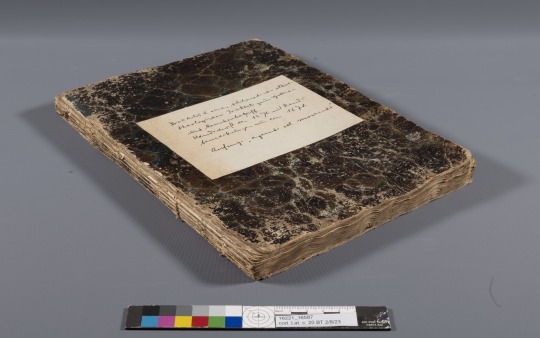
Though we prefer reattaching loose boards where possible, in this case it was determined that splitting or lifting the covering material from these very thin, irregular boards would cause damage. We therefore decided, in collaboration with the curator, that the marble paper covered boards would be retained loose with the manuscript in a cloth-covered clamshell box, and the manuscript would be mended, resewn, and given a new binding.


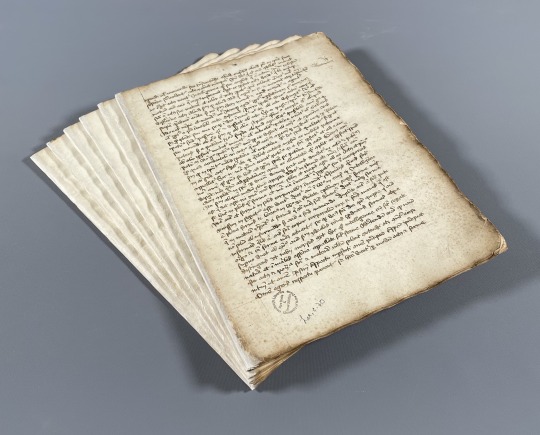
In the process of cleaning and mending the paper in preparation for resewing, a fragment of light blue paper was discovered adhered to one of the inner folios of the manuscript.
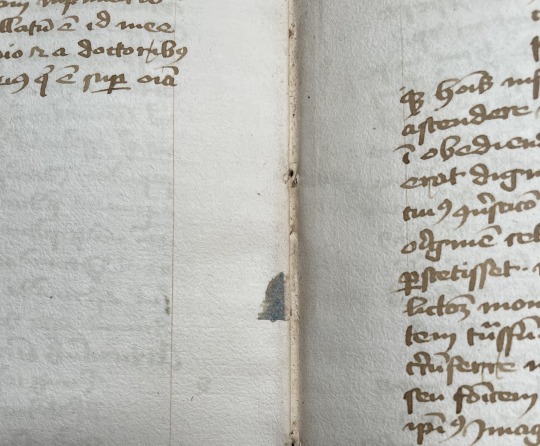
Though it is unclear why and when this paper fragment came to be attached to the manuscript, it is similar to the blue “sugar bag” paper found on many books from the 17th and 18th centuries. In constructing a new case for the manuscript, we used a thin (0.06”) piece of ABM board and covered it with Ruscombe Mills Sesley Sugar Bag handmade laid paper, which closely resembles the fragment of blue paper found inside the manuscript.



Although the new binding does not attempt to be a facsimile of any particular binding, the new case stabilizes the manuscript for use while echoing elements of the manuscript’s history with its thin, textured boards and light blue covering paper.
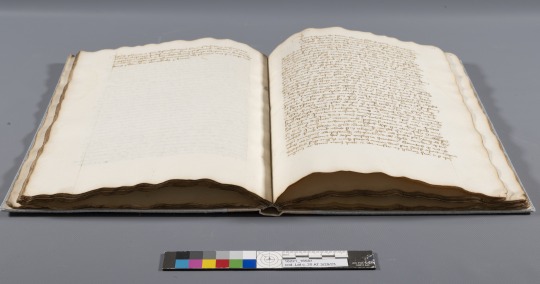

#ndpreservation#conservation#bookconservation#manuscriptmonday#handmadepaper#paperlove#bookbinding#denysthecarthusian#manuscript#rarebooks#NDLibraries
25 notes
·
View notes
Photo

Edge decoration is the next step in my book binding project. This step is extraneous, but I decided to do it because the page edges of my book had become discolored with grime after nearly a century. Edge decoration can be very fancy, with gold gilding or even painted scenery. My treatment is simple: a watercolor wash finished with a layer of beeswax. First the book needs to be clamped, edges dampened with a sponge, and then scraped (with a cabinet scraper) and sanded. The green edges of my book now correspond with the marbled endsheets and the child’s clothing from the original cover image. #donwidmerpaperarts #bookbinding #finebinding #edgedecoration #bookarts #bookconservation https://www.instagram.com/p/Cpx7GsrvaUa/?igshid=NGJjMDIxMWI=
2 notes
·
View notes
Photo

5 Things To Watch Out For When Hunting For Old Books! ☀️FOXING 😷RED ROT 🐛BUGS 💧WATER DAMAGE ☠️ARSENIC AND EMERALD GREEN . Happy hunting! -BDB . . . #oldbooks #antiquebooks #antiquenookstagram #redrot #silverfish #bookstagram #bookconservation
#antiquarianbooks#bookstagram#antiquarianbookstagram#independantbookstores#oldbooks#onlinebookstore#independantonlinebookstore
0 notes
Photo

This week, our new(ish) conservator Garrett has been sewing a book on Occult Philosophy (1651) in preparation for rebinding. The book features plenty of bizarre and spooky images, and is also a great example of 17th century printing practices. Stay tuned for to see progress on the rebinding! #conservation #bookconservation #msuspecialcollections #rarebooks (at MSU Libraries) https://www.instagram.com/p/B4VXmihp-lh/?igshid=erebthsopevs
701 notes
·
View notes
Video
Conservator, Andrea Krupp is rebinding a collection of Frank Leslie’s Illustrated Newspaper using a sewing frame. Here she is sewing a handy archival pocket for a foldout map to the binding. The bindery, by far has the best #ToolsOfTheLibraryTrade.
#ToolsOfTheLibraryTrade#bookbinding#LCPinsider#bookconservation#LCPrarebooks#narrativelibrarianship#specialcollections#tumblarians#iglibraries#19thcentury
88 notes
·
View notes
Photo
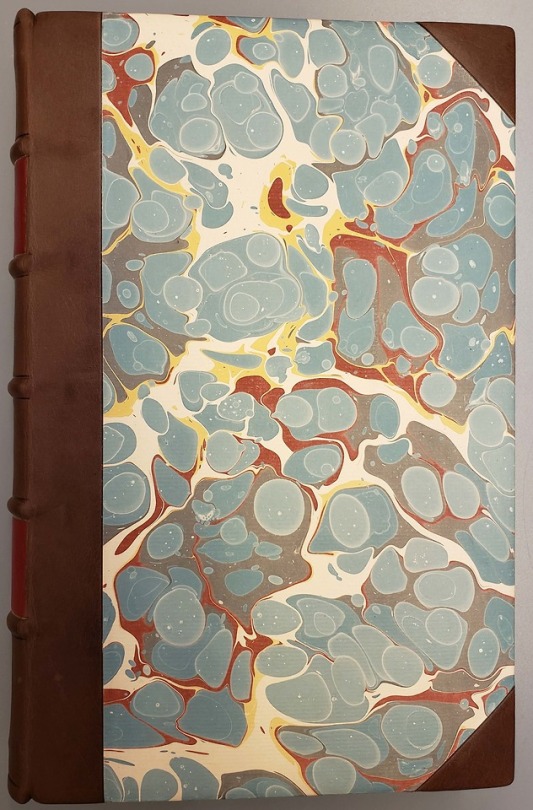
New binding with modern marbled paper
From: A collection of all the acts of Assembly, now in force, in the colony of Virginia. Williamsburg : Printed by William Parks, 1733
KFV2430 1733 .A2
#marbledmonday#marblemonday#papermarbling#marbling#bookrestoration#bookconservation#beautifulbooks#leatherbinding#rarebooks#specialcollections#libraryofva
14 notes
·
View notes
Photo

TBT to a few weeks ago when Maria Fredericks taught a workshop at @uilibraries on Long Stitch bindings . . #uictrbook #uilibraries #uiowagraduatecollege #bookarts #bookconservation #bookconservator #craftmanship (at University of Iowa) https://www.instagram.com/p/B3uPerNJBXr/?igshid=1culqxz677hxb
9 notes
·
View notes
Text
Paperback care
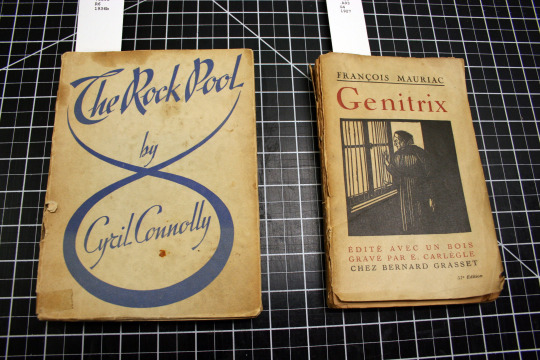

When working with our Robert Giroux book collection, I often come across beautiful early 20th century paperbacks that need a little TLC. I love the cover designs of these literary works and hate to see them crumbling because of the paper quality, shelf wear and a bit of mishandling over the years. Sometimes I find books that have been tied with cotton twine to keep covers attached. While the twine is technically archival, this can further damage an aging paperback because it puts pressure on sensitive points: namely the spine joints and fore-edges of the books. (see crude comic below)

My solution is to remove the twine and adhere the cover with a carefully cut strip of Japanese tissue paper and archival wheat paste. You cannot see the tissue in the post-repair pictures below, and that is a good thing!


I then get rid of the twine altogether and construct a four-flap enclosure for the book instead. These are much better at protecting all surfaces of the paperback from shelf wear.

Voila! This paperback is all tucked in and ready to be returned to its shelf.
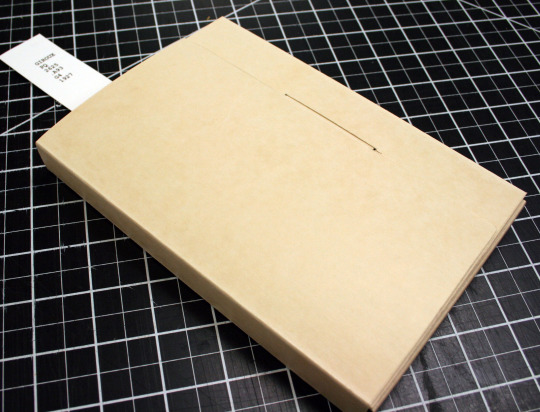
#bookconservation#preservation#vintage paperbacks#robert giroux#book arts#Special Collections & Archives#loyola university new orleans#Monroe Library
187 notes
·
View notes
Text
BOOKCON
I'm going to bookcon this year and want more people to meet! If were mutuals or just wanna say hi, message me!! I'd love to meet you guys at Con.
#books#bookcon#bookconservation#bookcon2019#bookish#bookshelf#bookworm#books and libraries#booklover#reading#readers#nerd#nerdlife#book nerd#trc soc aftg#aftg#aftgedit#trc#trcedit#soc inej#booktube#author
3 notes
·
View notes
Text
Preservation Week 2024
Virtual Presentation
Go Violets!: The History & Conservation of NYU’s Yearbook Collection
Date & Time: Wednesday, May 1, 2024 · 11 AM - 11:45 AM EDT
Location: Virtual
RSVP: eventbrite
Event Series: NYU Libraries Preservation Week 2024

In celebration of Preservation Week 2024, the Barbara Goldsmith Preservation & Conservation Department is hosting a virtual presentation exploring NYU Libraries’ extensive yearbook collection. The collection contains almost 1000 yearbooks dating from 1887 to 2012 issued by New York University and its component schools. It is one of the most heavily used collections in the New York University Archives. University Archivist Janet Bunde will discuss the history and use of the collection, and Special Collections Conservator Dawn Mankowski will discuss conservation treatment and her recent survey of the collection that will be used to guide our preservation priorities and ensure continued access to this important record of NYU history.
Collection Information:
https://findingaids.library.nyu.edu/archives/mc_304/
Janet Bunde (she/her) is the University Archivist in the Special Collections Department at NYU Libraries where she is dedicated to the stewardship and preservation of the collections. Janet holds a BA in history with a concentration in peace and conflict studies from Haverford College, and an MA in history with a certificate in archival administration from New York University.
Dawn Mankowski (she/her) is a Special Collections Conservator in the Barbara Goldsmith Preservation & Conservation Department at NYU Libraries where she cares for and carries out conservation treatment on NYU’s library and archival collections. Dawn holds a BA in Art History and Anthropology from the University of Arizona, and an MA in the Conservation of Art from SUNY Buffalo State College, specializing in Library and Archives Conservation.

#PreservationWeek2024#PreservationWeek#NYULibraries#NYUSpecialCollections#librarypreservation#libraryconservation#collectionscare#paperconservation#bookconservation#preservingthepast
2 notes
·
View notes
Text

The great haul from the Canadian Bookbinders and Book Artists Guild 40th anniversary meeting. I taught a workshop and watched some nice presentations. Worth a visit to London, Ontario.
16 notes
·
View notes
Text
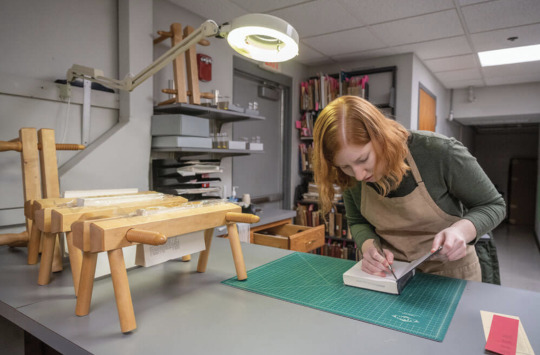
Student Employees Preserve Access to Collections
Our conservation lab team includes talented student employees who address the various treatment needs of high use Hesburgh Libraries collections. We are pleased that Megan Sherry, one of our current conservation assistants, is featured in Notre Dame Magazine describing her conservation work and sharing what she enjoys most about the job. Check out the full article here: https://magazine.nd.edu/stories/all-in-a-days-work-2/
9 notes
·
View notes
Photo
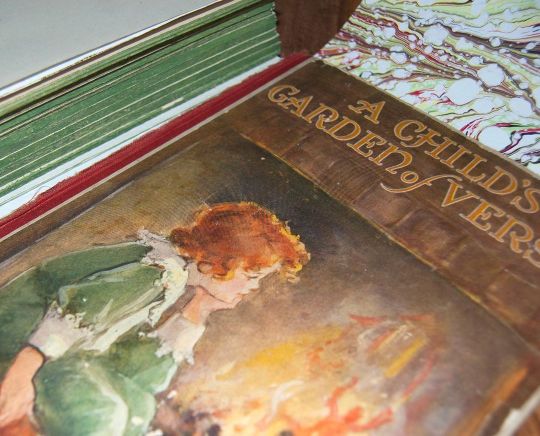
Edge decoration is the next step in my book binding project. This step is extraneous, but I decided to do it because the page edges of my book had become discolored with grime after nearly a century. Edge decoration can be very fancy, with gold gilding or even painted scenery. My treatment is simple: a watercolor wash finished with a layer of beeswax. First the book needs to be clamped, edges dampened with a sponge, and then scraped (with a cabinet scraper) and sanded. The green edges of my book now correspond with the marbled endsheets and the child’s clothing from the original cover image. #donwidmerpaperarts #bookbinding #finebinding #edgedecoration #bookarts #bookconservation https://www.instagram.com/p/Cpx6oMXv49J/?igshid=NGJjMDIxMWI=
1 note
·
View note
Photo

Our winter workshops are now on the website, it’s a great present for yourself or a friend. Learn to make hard cover books, use gouache in your artwork, or make a clamshell box or other preservation enclosures. See the full list and registration information on our website. #bookbinding #bookarts #lettering #surfacedesign #clamshellbox #preservationenclosure #caseboundbook #sewnboardbinding #bookconservation https://www.instagram.com/p/CXhho4pszdC/?utm_medium=tumblr
#bookbinding#bookarts#lettering#surfacedesign#clamshellbox#preservationenclosure#caseboundbook#sewnboardbinding#bookconservation
0 notes